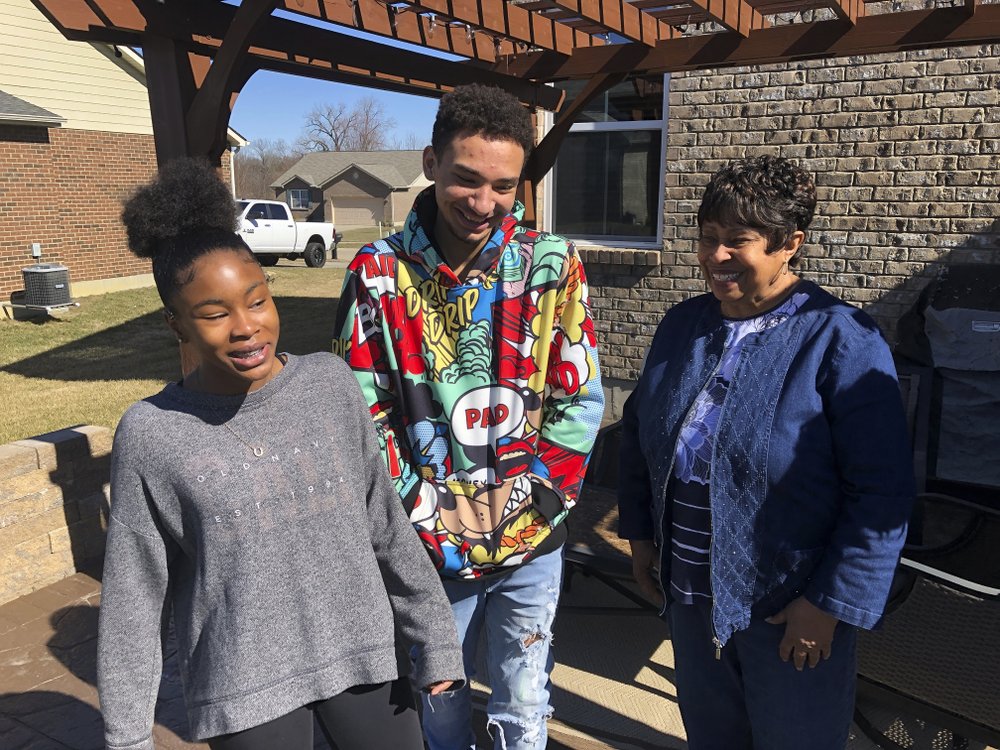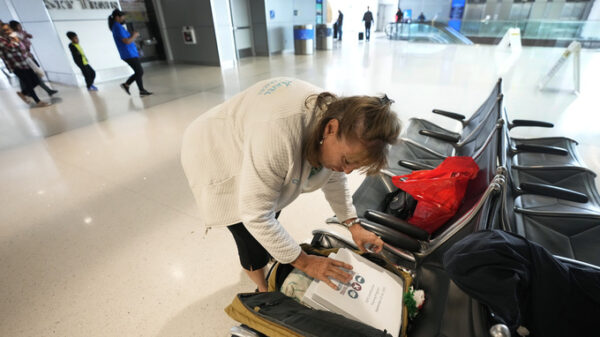Brilee Carter, left,13, and Cobe Calhoun, 17, share a laugh with their great-grandmother, Doris Rolark, outside Rolark’s daughter’s home on March 7, 2021, in Monroe, Ohio. The pandemic and its isolating restrictions have been especially tough for many of the nation’s some 70 million grandparents, many at ages when they are considered most vulnerable to the deadly COVID-19 virus. Rolark, of Middletown, Ohio, has always been active with the offspring. She raised three children mostly on her own, had five grandchildren (two now deceased), and has helped a lot with some of her 16 great-grandchildren. (AP Photo/Dan Sewell)
CINCINNATI (AP) — No sleepovers with popcorn and Disney movies. No dance recitals or holiday pageants, let alone any Grandparents’ Day for visiting the kids’ classrooms.
No hugs.
The first 12 months of the pandemic represent a lost year for many in the largest group of grandparents in U.S. history. Most of the nation’s some 70 million grandparents are in the fourth quarter of their lives, and the clock has kept running.
“Working with older adults, I’m seeing a lot of depression, a lot of increases in loneliness,” says Nick Nicholson, a nursing professor and researcher on aging at Quinnipiac University in Hamden, Connecticut. “It’s been really difficult … the anxiety, the despair, the social isolation. Over time, there are so many adverse effects. The sooner we expand the bubble, the better, so people can start healing together.”
The federal Centers for Disease Control and Prevention last week offered some beginning steps forward for Year 2, saying fully vaccinated grandparents could visit in a single household with healthy children and grandchildren without masks or other special precautions.
Doris Rolark blew air kisses to her mask-wearing grandchildren and great-grandchildren when they dropped off presents on her 78th birthday last month. She resumed hugs last week after the CDC guidelines were announced.
“It was great. I’m getting excited to see the rest of them,” says the Middletown, Ohio, woman, who has three grandchildren and 16 great-grandkids. “I hope it’s going to be better now.”
Joe and Nancy Peters had one of their 11 grandchildren over to visit last week as they began “cautiously returning to normal,” he says. Both retired educators in their 70s, they were used to being heavily involved with the grandchildren, all living near them in suburban Cincinnati, before the pandemic and its safety restrictions hit.

It was especially tough losing time with the youngest.
“They’re 3, 4, and 5 years old and a whole year has gone,” Nancy Peters says. “They’ve changed a lot … and Amelia would say each day to her Mom, ‘I am going to have a sleepover at Grandma’s when coronavirus is over.’
“And now she isn’t 3 anymore,” she says.
Both Peters and Rolark have been fully vaccinated as the shot pace has picked up nationally in recent weeks, with an estimated 60% of those 65 and older getting at least one dose so far. But the CDC reports that only 10% of the population as a whole has been fully vaccinated and reminds that vulnerability increases with age. The CDC says eight of 10 people who have died in the United States from the virus were 65 or older.
Nicholson says that while some older adults are “just breaking down the door to get out” after a year of isolation, others remain apprehensive with variant strains and other unknowns ahead.
“They wonder: Is it safe?” he says.
PRESCRIPTION: CAUTION
Joaniko Kohchi, who heads the Institute for Parenting at Adelphi University in Garden City, New York, says grandparents and other family members need to be cautious as they try to return to something that passes for normalcy.
“There’s going to be unquestionably a period of adjustment that will continue; planning and flexibility is really important,” she says.
Also unknown: how much some older adults have been hurt not only emotionally but mentally by losing in-person contacts and other activity outside their homes for a year.

Copyright 2020 Associated Press. All rights reserved.








































